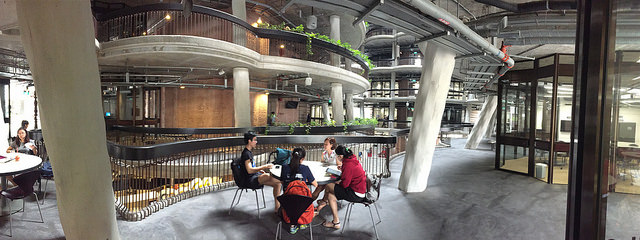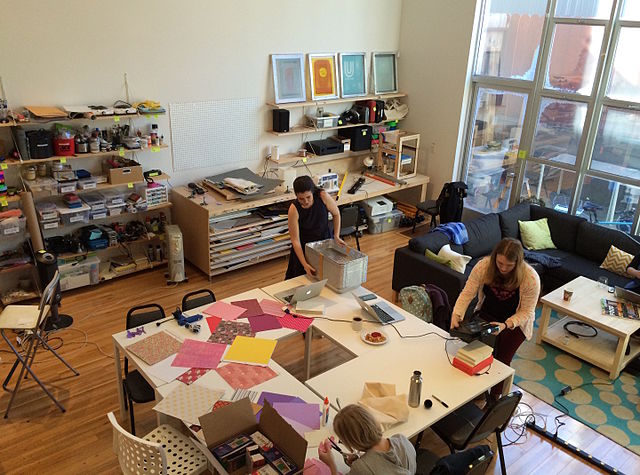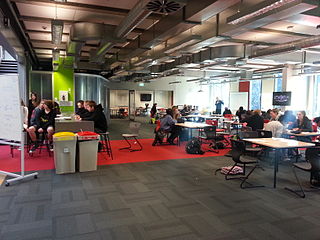Learning innovations: It's always going to be a hybrid model
Disclaimer: This article is the opinion of the author and does not necessarily reflect that of all Teachers' Christian Fellowship members.
Learning innovations: It’s always going to be a hybrid model
What’s the best way for students to learn? Are students being adequately prepared for a future when half the current jobs won’t exist? Are NAPLAN results the best indicators of student achievement? These, and similar questions, have always dominated educators’ minds, and increasingly parents, as some schools provide alternatives to traditional schooling.
Before proceeding, I want to make it clear that I believe there are many innovative teachers in government and non-government schools that have developed their teaching by either committing to or selecting innovations that are increasing the learning of their students. Similarly, there are schools that have taken a whole school approach to some learning innovations and are making a difference for student learning in their school. I would want to encourage them to continue. My concern is why innovation has not been adopted more widely to improve the education of all students.
Structural inertia
Schools in Australia have always worked on the industrial model of arranging students in age cohorts, placing them in a classroom, giving them one or more (with part-time work) teachers in primary schools, and in secondary schools, a number of teachers. A curriculum is mandated that, in recent decades, has become more and more prescriptive. Against this norm, there have always been alternatives- composite classes including one teacher schools in remote country areas; small independent schools with a different philosophy and organisation. But to ensure a guarantee to the community about standards, the states control curriculum and through a mixture of legislation and negotiation have brought all schools under their curriculum and testing authorities.
Against this standardisation, school systems, schools and often teachers have wanted to introduce new and different ways of doing education. Restricted by curriculum and accountability measures, their innovation has focussed primarily on the classroom teaching with some schools taking a whole school approach. Over the last century there has been no shortage of reported teaching and learning innovations backed by research and trialling. Almost universally they have been successful when implemented fully and passionately. But overall they have not been widely adopted or at best some aspects have been integrated into teaching. One reason is that doing something different, that does not have school and system support (different to permission) always places a huge burden on the teacher to develop programs, suitable resources, negotiate different spaces and to still meet the school and system reporting and assessment programs all set up to favour the industrial model. It’s just too hard to sustain innovation despite identifiable improvements and individual passion and commitment.
Schools have also been constrained by the disciplines. While there has been a movement away from learning areas, individual subjects still dominate the secondary curriculum. Multi-discipline and interdisciplinary subjects have always been viewed as being less able to add to learning as the single discipline subjects. Imagine secondary history being absorbed into a multi-disciplined approach or mathematics. Yet, over the years there have been some important recommendations about how students might be better prepared for the future, including continuing their learning beyond school, if more multidisciplinary and interdisciplinary approaches were adopted.
Teacher scepticism
All of that said, research still indicates that the teacher accounts for 50% of the difference between classrooms. A good teacher can make a success of any verified successful teaching approach. The multifaceted abilities of the good teacher and their passion for a particular approach carries the students to higher learning. But on the whole, teachers don’t like to be required to implement innovations that they are not committed to and doubt their effectiveness. They are mainly late implementers because they believe that many innovations are politically driven, and if they wait long enough, they will go away. Do you remember - national learning profiles, key competencies, quality assurance, learning styles, project learning, multiple intelligences, civics education, values education, quality teaching, financial literacy, service learning. Yet, all of these are valuable, but at best, some individual teachers have adopted parts of them.
On a whole school basis, innovation has often worked when all staff members have developed an ownership for the innovation and been enthusiastic to implement it. However, innovations in teaching usually require funding which is often available to initiate, but rarely sustained over time. Teachers lose enthusiasm, question whether what they are doing is really worth the extra work and don’t get enough positive feedback, including hard learning data, to encourage them. All this without the problem of changes to staff, including school leaders, that results in a different preferred innovation.
Given the plethora of innovations available, teachers are right to be sceptical about each new one. They do need to question the research base, implementation reports, philosophy about how students learn and the ethical nature of the teaching methodologies. Not all changes are good. There are many booksellers, academics and other writers and presenters who are looking for profit. For them, doing the professional development meeting circuit with an innovation and a book can be financially rewarding.
Adopting an innovation
Teachers are eclectic. They are conscious of their circumstances and will pick and choose what they think might match them. This explains why they like teaching ideas but rarely want to adopt a change that will be so invasive as to change their basic approach to teaching. Nonetheless, some teachers are early innovators and want to try new things. What should they look for in an innovation?
A basic checklist is:
- Is it founded on recognised learning theory?
- Has it been successfully trialled?
- Was the trial externally evaluated?
- How can the innovation help students and will it help all of them or only some?
- How will I need to change my teaching to implement it?
- How much does it cost and what other resources are needed?
- Will it accommodate my school’s priorities and curriculum focus?
- How can I be assured that my students have learnt through this innovation?
When it comes to whole-school programs the questions are the same, but there is an additional layer of school and system implementation strategies aimed at getting teachers onside, involved and able to implement the innovation through professional learning support. There is a wealth of literature on this matter and I am not going to repeat it here.
In practice
As an outcome of the above discussion, two current innovations are considered – one classroom focussed and the other whole school. Both are excellent innovations but the issues associated with implementation as discussed above are likely to affect both.
Example 1 – Transforming schools: Creativity, critical reflection, communication, collaboration. Jefferson and Anderson 2017

This new book makes a very good point about the relevance of today’s education for the future with an emphasis on the sort of skills that will be needed for future jobs. It questions the effectiveness of a focus on NAPLAN results at the expense of teaching the 4Cs - creativity, critical reflection, communication and collaboration. It is classroom focussed, imploring teachers to take a different approach to emphasise these skills, but also looks at what it means to have a whole school approach.
There is much that teachers can take from this publication. There are already many primary classrooms that have this focus, but in secondary schools the organisational, curriculum and assessing restraints perceived by teachers, make implementation more difficult. The authors argue that teachers need political, policy and resource support to make hard changes possible through professional learning. They also acknowledge that it will take time to see improvement, something that will not endear it to politicians.
Some teachers may attempt implementation as recommended, but most teachers will take what they can from this book, integrate it into their teaching and innovation will continue to be a hybrid model.
Example 2 Open and flexible learning spaces
These are not the same. An open learning space is a large space where a number of classes can be accommodated whereas, the flexible learning space can be configured to suit different size groups as well a large number.

Behind both of these concepts is the belief that students can learn better through expert presentation, working in groups and being able to form and reform groups to suit the task. More importantly, it places a huge emphasis on the task – an activity that will capture a range of learning outcomes usually across a number of disciplines.
There are well documented advantages for learning if students work mainly in groups on tasks that cross the disciplines.  Many primary classrooms, without the open space or flexible learning areas, have operated this way. Primary teachers are good at using both multi-discipline tasks and group work. One of the facilitating features has been the primary classroom structure and flexibility in configuration allowed for by smaller children and furniture. They have not found the need to make much use of open and flexible learning spaces.
Many primary classrooms, without the open space or flexible learning areas, have operated this way. Primary teachers are good at using both multi-discipline tasks and group work. One of the facilitating features has been the primary classroom structure and flexibility in configuration allowed for by smaller children and furniture. They have not found the need to make much use of open and flexible learning spaces.
In secondary schools, the classrooms are no larger, possibly smaller, the students and furniture are bigger. Reconfiguring classrooms for group work can be very challenging, especially when it must be reconfigured to the original format at the end of the period. For practical reasons some schools have decided to move to open space learning where a whole year group might be accommodated in the one space. The space allows students to be arranged into various sized groups depending on the task. A teacher is designated to provide any presentation input that is needed and to explain the task. Other teachers, who are already briefed on the task, are there to assist the groups. Sounds good, but there are issues.

The task needs to be involving for the students, challenging, but not too difficult for some students who may be struggling with school. This can be “mission impossible”, but mitigated by how groups are formed. Until recent years, many secondary teachers have believed that you put students into groups, one student does the work and the others copy. This view challenges the nature of the group. It must be configured not simply to accommodate a range of student abilities, but so that each person in the group has a specific sub task that contributes to the group task. Without this additional layer, group work may well reflect the earlier description. Even if it is a simple discussion, there needs to be a leader, a recorder, a reporter and a person to keep the group on task as per an agreed methodology. Teaching students how to work in groups is a priority.
Although difficult in open learning spaces, but easier in flexible learning spaces, individual differences may need to be accounted for by drawing off some groups of students for revision, remedial work, homework correction or some explicit teaching of a concept they have missed possibly through being absent.
Further issues for this innovation are:
- The tracking of individual student progress. Who are students accountable to and does each involved teacher have responsibility for particular students?
- How do you deal with disruptive students and those who don’t want to work? Can they hide in a group structure?
- Who assesses students’ work and provides them with meaningful feedback to help them improve?
- Who is responsible for tracking the various curricula and programming to ensure coverage?
Open and flexible learning spaces are a great innovation to help students achieve the broader learning outcomes including, cooperation, collaboration, critical thinking and problem solving, but they require a huge commitment to organisation and administration especially in task construction and monitoring the learning of all students.
I am sure most schools practicing this innovation will say that it is worth it, but for others it remains a challenge.
Schools and teachers will take what they want from this approach and integrate it into their learning and teaching and innovation will continue to be a hybrid model.
John Gore